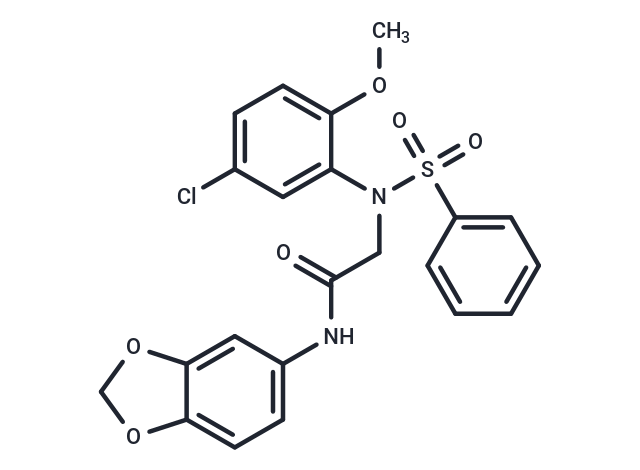Shopping Cart
- Remove All
 Your shopping cart is currently empty
Your shopping cart is currently empty

LX2343 is a BACE1 enzyme inhibitor with an IC50 value of 11.43±0.36 μM and acts as a non-ATP competitive PI3K inhibitor with an IC50 of 15.99±3.23 μM. Additionally, LX2343 stimulates autophagy, promoting Aβ clearance.

| Pack Size | Price | Availability | Quantity |
|---|---|---|---|
| 2 mg | $31 | In Stock | |
| 5 mg | $48 | In Stock | |
| 10 mg | $76 | In Stock | |
| 25 mg | $139 | In Stock | |
| 50 mg | $241 | In Stock | |
| 100 mg | $358 | In Stock | |
| 200 mg | $497 | In Stock | |
| 1 mL x 10 mM (in DMSO) | $53 | In Stock |
| Description | LX2343 is a BACE1 enzyme inhibitor with an IC50 value of 11.43±0.36 μM and acts as a non-ATP competitive PI3K inhibitor with an IC50 of 15.99±3.23 μM. Additionally, LX2343 stimulates autophagy, promoting Aβ clearance. |
| Targets&IC50 | β-Amyloid:, Autophagy:, PI3K:15.99 μM, BACE1:11.43 μM |
| In vitro | LX2343 (5-20 μM) effectively reduces Aβ accumulation in HEK293-APPsw and CHO-APP cells and enhances Aβ clearance in SH-SY5Y cells and primary astrocytes, demonstrating promise for Alzheimer's disease (AD) treatment through its dual action of inhibiting Aβ production and encouraging its clearance. This compound notably improves cognitive function in APP/PS1 transgenic mice. Despite not affecting BACE1 protein levels in HEK293-APPsw and CHO-APP cells, LX2343 dose-dependently inhibits BACE1 enzymatic activity, with an IC50 of 11.43±0.36 μM (TDC as a positive control). Further investigation reveals LX2343 as a non-ATP competitive inhibitor of PI3K, showing unaffected inhibition by ATP at various concentrations. Specifically, the IC50 values of LX2343 are 13.11±1.47 μM at 10 μM ATP, 13.86±1.12 μM at 50 μM ATP, and 15.99±3.23 μM at 100 μM ATP, underscoring its potential utility in AD treatment by operating through mechanisms independent of ATP competition. |
| In vivo | (APP/PS1 mice, which express chimeric human Swedish mutant APP and a mutant human presenilin 1 protein, serve as an effective animal model for Alzheimer's Disease (AD) dementia. LX2343's ability to improve memory impairment is assessed in this model through the Morris Water Maze (MWM) test. It is observed that APP/PS1 transgenic mice display significantly longer path lengths and escape latencies in locating the platform during 8-day training trials compared to non-transgenic mice. Nevertheless, the administration of 10 mg/kg LX2343 notably reduces these prolonged path lengths and escape latencies on days 7 and 8. Additionally, in the probe trial assay, transgenic mice treated with LX2343 visit the platform's hidden location more frequently than those treated with the vehicle, indicating an amelioration of memory impairment.) |
| Kinase Assay | Inhibition of BACE1 enzyme by LX2343 is assayed using BACE1 activity kits in vitro. Briefly, BACE1 substrate (250 nM), BACE1 enzyme (0.35 U/mL), and varied concentrations of LX2343 (5, 10, and 20 μM) are sequentially incubated for 1 h at 37°C in the dark. Fluorescence intensity is measured with excitation and emission wavelengths at 545 and 585 nm, respectively |
| Cell Research | SH-SY5Y cells are transfected with mRFP-GFP-LC3 plasmids via an adenovirus. The cells are treated without or with Streptozotocin (0.8 mM) in combination with 5 or 20 μM LX2343 for 4 h and then fixed with 4% paraformaldehyde and observed using an Olympus Fluoview FV1000 confocal microscope |
| Animal Research | LX2343 is dissolved in 3% DMSO and 5% tween-80.MiceAPP/PS1 [B6C3-Tg(APPswe, PS1dE9)] transgenic mice are used. Genotyping to confirm APP/PS1 DNA sequences in their offspring is performed by assaying the DNA from tail biopsies, with Tg-negative mice as a negative control. Twenty male APP/PS1 mice are divided into two groups with ten non-transgenic mice in one group to serve as a negative control. The two 6-month transgenic groups are administered 10 mg/kg per day of LX2343 or vehicle, and the 6-month non-transgenic group is administered the vehicle for 100 d via intraperitoneal injection. After 100 d of administration, MWM assays are applied to evaluate the cognitive abilities of the mice for 8 d under continuous LX2343 treatment. Upon completion of the MWM test, the mice are euthanized, and the brains are removed and bisected at the mid-sagittal plane. The right hemispheres are frozen and stored at -80°C, and the left hemispheres are fixed in 4% paraformaldehyde |
| Molecular Weight | 474.91 |
| Formula | C22H19ClN2O6S |
| Cas No. | 333745-53-2 |
| Smiles | COc1ccc(Cl)cc1N(CC(=O)Nc1ccc2OCOc2c1)S(=O)(=O)c1ccccc1 |
| Relative Density. | no data available |
| Storage | Powder: -20°C for 3 years | In solvent: -80°C for 1 year | Shipping with blue ice. | |||||||||||||||||||||||||||||||||||
| Solubility Information | DMSO: 55 mg/mL (115.81 mM) | |||||||||||||||||||||||||||||||||||
Solution Preparation Table | ||||||||||||||||||||||||||||||||||||
DMSO
| ||||||||||||||||||||||||||||||||||||

Copyright © 2015-2024 TargetMol Chemicals Inc. All Rights Reserved.